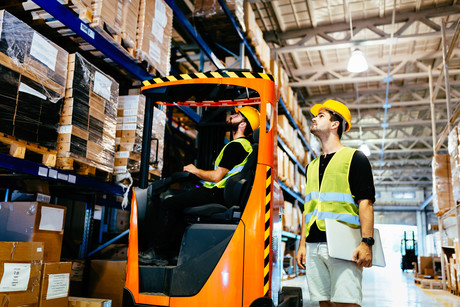How to improve safety around forklifts

Forklifts pose several risks to pedestrians in the workplace. The rear counterweight can turn very quickly (running the risk of crushing a pedestrian), plus they are heavy, take time to stop and have several blind spots.
Forklifts can be dangerous when not treated with respect and can inflict serious damage to worksite property and worse, cause injuries or even death.
The human and financial cost of forklift-related accidents is immense. But in reality, many forklift incidents could be avoided if operators followed best-practice forklift safety procedures.
Below are some tips to improve forklift safety procedures, and stop workers being injured.
1. Stabilise forklift loads and attachments
Falling loads present one of the greatest dangers for workers.
Pedestrian staff are most at risk when attempting to help the forklift operator in loading and unloading operations. Heavy loads that are not properly secured can slip and fall on the worker.
In addition, workers are at risk when the forklift is used in ways the manufacturer didn’t intend (eg, a forklift lifting more weight than it is designed to handle can cause the forklift to tip over).
Effective forklift safety procedures should ensure appropriate attachments are used for certain kinds of loads. Workers unsure of how the attachments work should be trained as soon as possible.
Ensure workers never overload forklifts and correct attachments are fitted. Loads need to be properly stabilised before moving them.
2. Set up safety exclusion zones to segregate pedestrian workers from forklifts
Keeping pedestrians away from forklifts minimises the likelihood of accidents resulting in injury or death.
Designate safety exclusion zones for both forklift operators and pedestrians, keeping them a safe distance apart.
Include forklift safety procedures to make sure people are where they should be. To do so, you can use physical barriers including:
- fences
- guardrails
- bright tape stuck to the floor
- boom gates
- traffic lights.
Another option for keeping pedestrians away from mobile plant is constructing overhead walkways to provide workers a way to walk over areas where heavy vehicles operate.
Also, make sure workers always comply with the rules and regulations of the workplace.
3. Ensure forklift drivers always wear seatbelts
In a case where a forklift tips over or collides with a wall, seatbelts can save the drivers from injury or death.
Seatbelts prevent drivers being thrown out of the forklift and out of harm’s way in the event of heavy load falling. Make sure forklift operators always wear seatbelts — it needs to be compulsory while operating forklifts. Use signs placed around the workplace to remind workers.
Check all seatbelts in forklifts are in good condition and fitted correctly (as per the manufacturer’s instructions). In a worst-case scenario, a seatbelt that does its job will save lives.
4. Keep people a safe distance using proximity warning systems
Keeping pedestrian staff a safe distance from forklifts can be challenging. Often pedestrians are required to work near mobile plant.
Workers are only human; the risk of injury or death will always be prominent on worksites. They therefore need to be protected from accidents that may come from poor visibility, blind spots, fatigue, inattention and non-compliance.
One of the best ways to stop a worst-case scenario from eventuating is to utilise pedestrian safety warning systems as an on-site control.
These systems keep pedestrians separate and safe away from the danger of moving vehicles.
If a pedestrian gets too close to a forklift, the driver gets a clear warning to brake immediately, giving the driver a chance to brake and avoid a potentially fatal accident.
Intercity train depot deploys advanced safety system
An advanced safety system was recently implemented at a NSW train maintenance facility, designed...
Reducing hazards during mining haul truck maintenance
Haul trucks and dumpers are among the equipment that is most frequently associated with accidents...
Immersive VR training to keep forestry workers safe
A newly developed immersive VR training tool could enable forestry workers to be trained in a...










